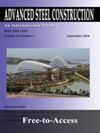钢框架剪切膜片耗能器的单调和循环试验
IF 1.7
3区 工程技术
Q3 CONSTRUCTION & BUILDING TECHNOLOGY
引用次数: 23
摘要
本报告描述了一系列循环试验的屈服剪切板装置的形式提出的U. Dorka(未发表)在卡塞尔大学,德国。该装置由一个短长度的方形空心截面(SHS)组成,内部焊接有膜片。它位于支撑框架的支撑和主要构件之间,隔膜位于框架的平面内,因此当框架发生横向变形时,它以纯剪切方式加载。在单调和循环荷载下,对安装在单层平面k支撑框架上的100毫米方形耗散装置进行了一系列广泛的试验。事实证明,这种设备制造、安装、拆卸和更换都很容易,而且价格低廉。所有测试的设备都产生了相当低的变形,并保持了非常大的延展性而没有失效。在屈服后,装置所承受的载荷继续增加,在大多数试验中,最大承受力与屈服力之比约为1.7。虽然具有2mm隔膜的装置似乎提供了最大的能量耗散能力,但较薄的装置在重复的大振幅循环下容易屈曲和断裂。建议厚度为3毫米(即厚度与宽度之比为0.03),以提供耗散能力和鲁棒性的最佳组合。一个3毫米的装置耗散了大约1.3 kJ的能量,当它所安装的框架经历了一个振幅为30毫米的单位移周期。结论是,这些装置提供了一种简单、廉价和可靠的方式来耗散地震荷载框架中的大量能量。第4.6节提供了钻机设计的一些改进和进一步工作的建议。本文章由计算机程序翻译,如有差异,请以英文原文为准。
Monotonic and Cyclic Tests on Shear Diaphragm Dissipators for Steel Frames
This report describes a series of cyclic tests on a yielding shear panel device of the form proposed by U. Dorka (unpublished) at the University of Kassel, Germany. The device consists of a short length of square hollow section (SHS) with a diaphragm plate welded inside it. It is positioned between the braces and the main members of a braced frame, with the diaphragm lying in the plane of the frame, so that it is loaded in pure shear as the frame undergoes lateral deformation. An extensive series of tests on 100 mm square dissipative devices mounted in a single-storey, planar, K-braced frame was successfully performed, under both monotonic and cyclic loads. The devices proved easy and cheap to manufacture, fit, remove and replace. All the devices tested yielded at quite low deformations and sustained very large ductilities without failure. The load carried by the device continued to increase after yield, with a ratio of maximum force carried to yield force of around 1.7 in most tests. While a device with a 2 mm diaphragm appeared to offer the maximum energy dissipation capacity, thinner devices were prone to buckling and to fracture under repeated large- amplitude cycling. A thickness of 3 mm (i.e. thickness to breadth ratio of 0.03) is recommended as offering the best combination of dissipative capacity and robustness. A 3 mm device dissipated approximately 1.3 kJ of energy when the frame in which it was fitted underwent a single displacement cycle of amplitude 30 mm. It is concluded that these devices offer a simple, cheap and robust way of dissipating significant amounts of energy in seismically loaded frames. Some improvements to the rig design and suggestions for further work are offered in section 4.6.
求助全文
通过发布文献求助,成功后即可免费获取论文全文。
去求助
来源期刊

Advanced Steel Construction
CONSTRUCTION & BUILDING TECHNOLOGY-ENGINEERING, CIVIL
CiteScore
2.60
自引率
29.40%
发文量
0
审稿时长
6 months
期刊介绍:
The International Journal of Advanced Steel Construction provides a platform for the publication and rapid dissemination of original and up-to-date research and technological developments in steel construction, design and analysis. Scope of research papers published in this journal includes but is not limited to theoretical and experimental research on elements, assemblages, systems, material, design philosophy and codification, standards, fabrication, projects of innovative nature and computer techniques. The journal is specifically tailored to channel the exchange of technological know-how between researchers and practitioners. Contributions from all aspects related to the recent developments of advanced steel construction are welcome.
 求助内容:
求助内容: 应助结果提醒方式:
应助结果提醒方式:


